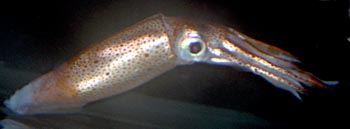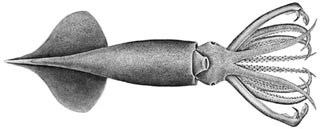Gonatidae
Richard E. Young, Michael Vecchione, and Tsunemi Kubodera


This tree diagram shows the relationships between several groups of organisms.
The root of the current tree connects the organisms featured in this tree to their containing group and the rest of the Tree of Life. The basal branching point in the tree represents the ancestor of the other groups in the tree. This ancestor diversified over time into several descendent subgroups, which are represented as internal nodes and terminal taxa to the right.

You can click on the root to travel down the Tree of Life all the way to the root of all Life, and you can click on the names of descendent subgroups to travel up the Tree of Life all the way to individual species.
For more information on ToL tree formatting, please see Interpreting the Tree or Classification. To learn more about phylogenetic trees, please visit our Phylogenetic Biology pages.
close boxIntroduction
These are mostly muscular squids of moderate size but are unusual in having the armature on the arms in four, rather than two, series (occasionally more than four series near the arm tips). The two medial series are usually hooks. Often the tentacular club has one very large centrally located hook. Species of the genus Gonatopsis are unusual in that the tentacles are lost in the early juvenile stage and remain lost through all older stages.
Diagnosis
An oegopsid ...
- with tetraserial armature on arms.
- usually with hooks on arms and often on tentacular clubs.
Characteristics
- Arms
- Arms with quadraserial armature except at arm tips in some species where sucker series increases.
- Arms I-III with hooks in two medial series except in Berryteuthis anonychus; the latter with hooks only in females at bases of dorsal arms.
 image info
image info Figure. Oral view of two arms of Gonatus steenstrupi with large hooks in the medial two series and a series of small suckers on each arm margin. Transmitted-light photograph by M. Vecchione aboard the R/V G. O. SARS, MarEco cruise to the central North Atlantic.
- Tentacles
- Tentacular clubs with numerous irregular series of suckers; additional hooks in some genera.
- Tentacular clubs with unique locking-apparatus consisting of a series of elongated ridges with medial suckers and knobs in Gonatus and Eogonatus.
 image info
image info Figure. Oral view of the proximal region of the club of G. steenstrupi. Arrow points to one ridge of the locking-apparatus. Transmitted-light photograph by M. Vecchione aboard the R/V G. O.SARS, MarEco cruise to the central North Atlantic.
- Buccal crown
- Buccal-crown connectives attach to ventral margins of arms IV.
- Buccal-crown connectives attach to ventral margins of arms IV.
- Funnel
- Funnel locking-apparatus with straight groove.
- Funnel locking-apparatus with straight groove.
- Photophores
- Photophores absent except in G. pyros (ocular patch).
- Photophores absent except in G. pyros (ocular patch).
- Gladius
- Gladius with primary conus.
Discussion of Phylogenetic Relationships
There have been several recent attempts to unravel the phylogeny of the Gonatidae. Nesis (1997) relied on similarity of morphology and, apparently, results of protein electrophoresis by Katugin (1993 and 1995) to derive the following relationships:
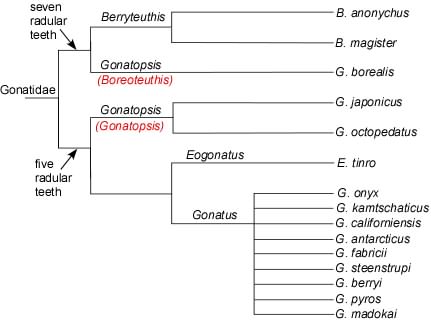 image info
image info
Figure. Phylogeny of the Gonatidae. Chart modified from Nesis (1997). Subgenera are in red. Nesis included only species that were well established as valid species. Nesis considered Eogonatus to be a subgenus of Gonatus.
Clearly if this phylogeny is correct then Gonatopsis is polyphyletic. More recently Katugin (2004) has reassessed the phylogeny of the gonatidae using electrophoretic analysis of allozymes. His results are seen below.
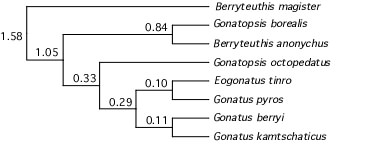 image info
image info
Figure. Phylogenetic tree of the Gonatidae. Chart modified from Katugin (2004). Numbers represent genetic distance based on protein electrophoresis. Branch lengths are not drawn proportional to genetic distance.
In the paper Katugin proposes a new classification of the Gonatidae with two subfamilies (Berryteuthinae and Gonatinae) based on the radula. Within the Berryteuthinae he includes Berryteuthis (B. magister), Boreoteuthis (for Gonatopsis borealis; he elevates the subgenus Boreoteuthis to generic level) and a new genus Okutania for Berryteuthis anonychus. In the Gonatinae he includes Gonatus (including Eogonatus) and the remaining species of Gonatopsis. Katugin's phylogeny based on allozymes is similar to that of Nesis (1997) however the allozyme data shows the Gonatinae nested within the Berryteuthinae.
Recent molecular data analyzed using parsimony from 12S RNA, 16srRNA, COI genes (Lindgren, et al, 2004) offer a somewhat different phylogeny of the family but without good bootstrap support for most nodes. This data suggests that the Gonatus is paraphyletic. Gonatopsis borealis groups more closely with Berryteuthis than other species of Gonatopsis as suggested by both Nesis (1997) and Katugin (2004).
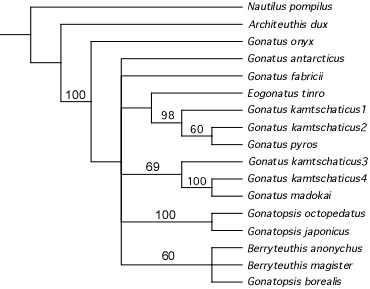 image info
image info
Figure. Phylogenetic tree of the Gonatidae. Chart simplified from Lindgren et al. (2004). Numbers represent bootstrap support for relationships derived from DNA analyses. Numberered G. kamtschaticus represent different morphological types.
Because of the uncertainty in gonatid phylogeny, we retain here the standard classification for the family.
Nomenclature
A list of all nominal genera and species in the Gonatidae can be found here. The list includes the current status and type species of all genera, and the current status, type repository and type locality of all species and all pertinent references.
Habitat and distribution
Gonatids are pelagic squids that occur from the surface to over 1000 m depth. Some species undergo extensive diurnal (diel) vertical migrations, ascending at night and descending during the day. A few species are associated with the ocean floor over the continental slope. Gonatids occur in high latitudes of both hemispheres. One species lives in antarctic waters, two in the North Atlantic and 16 in the high North Pacific where they are among the most abundant oceanic squids.
References
Nesis, K. N. 1982. Abridged dey to the cephalopod mollusks of the world's ocean. 385+ii pp. Light and Food Industry Publishing House, Moscow. (In Russian.). Translated into English by B. S. Levitov, ed. by L. A. Burgess (1987), Cephalopods of the world. T. F. H. Publications, Neptune City, NJ, 351pp.
Nesis, K. N. 1997. Gonatid squids in the Subarctic North Pacific: Ecology, biogeography, niche diversity and role in the ecosystem. Advances in Marine Biology. Academic Press, New York, p. 243-324.
Katugin, O. N. 1993. Study of relationships between different species of squid, family Gonatidae, by protein electrophoresis. In: Biology and Rational Use of Hydrobionts. Their role in ecosystems. Abstracts of communications of the TINRO Young Scientisit Conference, Vladivostok," p. 14-15. In Russian.
Katugin, O. N. 1995. Morphology, genetic difference, and evolution of Berryteuthis magister, Berriteuthis anonychus, and Gonatopsis borealis (Cephalopoda: Oegopsida). In: "Unitas Malacologica. 12th International Malacological Congress. Vigo, Spain. Abstracts." p. 312-313.
Katugin, O. N. 2004. Squids of the family Gonatidae from the North Pacific Ocean and their genetic differentiation: controversial issues in the systematics and phylogeny.Ruthenica 14(1): 73-87. In Russian with English abstract.
Lindgren, A. R., O. N. Katugin, M. K. Nishiguchi and E. Amezquita. 2004. Phylogenetic relationships among the Gonatidae (Cephalopoda, Teuthida, Oegopsida) based on DNA sequence data. Abstracts of the conference "Mollusks of the Northeastern Asia and Northern Pacific: Biodiversity, ecology, biogeography and faunal history." Vladivostok, Oct. 4-6, 2004. p. 89-92.
Okutani, T. and M. R. Clarke. 1992. Family Gonatidae Hoyle, 1886. P. 139-156. In: Sweeney, M. J., C. F. E. Roper, K. M. Mangold, M. R. Clarke and S. v. Boletzky (Eds.). "Larval" and juvenile cephalopods: A manual for their identification. Smithson. Contr. Zool. No. 513.
Young, R. E. 1972. The systematics and areal distribution of pelagic cephalopods from the seas off Southern California. Smithson. Contr. Zool., 97: 1-159.
Title Illustrations
| Scientific Name | Gonatus steenstrupi |
|---|---|
| Location | Central North Atlantic |
| Comments | Photographed in shipboard aquarium aboard the R/V G. O. SARS, MarEco cruise. |
| Specimen Condition | Live Specimen |
| View | Side |
| Copyright | © 2004 |
| Scientific Name | Gonatus berryi |
|---|---|
| Location | Off California, eastern Pacific Ocean |
| Reference | Young, R. E. 1972. The systematics and areal distribution of pelagic cephalopods from the seas off Southern California. Smithson. Contr. Zool., 97: 1-159. |
| View | Ventral |
| Size | 119 mm PL |
| Copyright | © 2004 Richard E. Young |
About This Page
Richard E. Young
Dept of Oceanography
University of Hawaii
Honolulu, Hawaii 96822
USA
National Marine Fisheries Service
Systematics Laboratory
National Museum of Natural History
Washington, D. C. 20560
USA
Tsunemi Kubodera
National Science Museum, Tokyo,
Department of Zoology
3-23-1 Hyakunin-cho, Shinjuku-ku,
Tokyo, 169 JAPAN
Correspondence regarding this page should be directed to Tsunemi Kubodera at
Page copyright © 1996 Richard E. Young, , and
Citing this page:
Young, Richard E., Vecchione, Michael, and Kubodera, Tsunemi. 1996. Gonatidae . Version 01 January 1996 (under construction). http://tolweb.org/Gonatidae/19414/1996.01.01 in The Tree of Life Web Project, http://tolweb.org/





